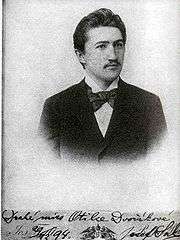Asrael Symphony

The Asrael Symphony for large orchestra in C minor (Czech: „Asrael“, Symfonie pro velký orchestr C moll), Op. 27 (1905–1906), is a Czech symphony composed by Josef Suk. Suk wrote the work in memory of his father-in-law and teacher, Antonín Dvořák (died 1904), and his wife (Dvořák's daughter) Otilie Suková (née Dvořáková) (died 1905).
Background
Suk began to compose his funeral[1] symphony at the beginning of 1905, about eight months after Dvořák's death. The composition was titled after Asrael (Azrael), known as the angel of death in the Old Testament[2] and as the Islamic carrier of souls after death.[3] The work is in five movements. Suk completed the sketches of three movements less than a half year later. On 6 July 1905, while Suk was in the middle of the work, his wife Otilie died.[4] Although the composition was to be also a celebration of Dvořák's life and work, the desolated composer rejected the optimistic tone of the rest of the work. Suk himself recalled:
- 'The fearsome Angel of Death struck with his scythe a second time. Such a misfortune either destroys a man or brings to the surface all the powers dormant in him. Music saved me and after a year I began the second part of the symphony, beginning with an adagio, a tender portrait of Otilka.'[5]
Suk completed the score on 4 October 1906. He dedicated the work "to the exalted memory of Dvořák and Otilie",[6] in particular the last two movements to Otilie.
The symphony was premièred on 3 February 1907 at the Prague National Theatre, conducted by Karel Kovařovic. Karel Hoffmann and Jiří Herold, members of the Czech Quartet, attended the premiere as the concertmasters of the orchestra of the National Theatre.[7]
Structure
The composition is in five movements:
- Andante sostenuto
- Andante
- Vivace
- Adagio
- Adagio e maestoso
The influence of Dvořák's composing style, apparent in Suk's previous work, is not noticeable in this composition, according to Vysloužil, who writes that Suk develops his musical language rather toward modern polyphonic and harmonic techniques.[8] Suk included several music quotations in tribute to his father-in-law and wife, including quotes from Dvořák's Requiem and opera Rusalka.[5]
Instrumentation
The symphony is scored for piccolo, 2 flutes, 2 oboes, cor anglais, 2 clarinets in B-flat (A, E-flat), bass clarinet, 2 bassoons, contrabassoon, 6 horns (horns V and VI ad lib), 3 trumpets in C, 3 trombones, tuba, timpani, triangle, cymbals, bass drum, harp, and strings.
Notes
- ↑ Album notes (SU 3830-2), p. 10
- ↑ Andrew Clements (2011-03-31). "Suk: Asrael – review". The Guardian. Retrieved 2017-03-19.
- ↑ Tim Ashley (2001-02-28). "The sound of freedom". The Guardian. Retrieved 2017-03-19.
- ↑ Dopisy o životě hudebním i lidském, p. 60
- 1 2 Jessica Duchen (2010-02-19). "Observations: Suk's Angel of Death is not for the faint-hearted". The Independent. Retrieved 2017-03-19.
- ↑ Album notes (SU 3864-2), p. 10
- ↑ Dopisy o životě hudebním i lidském, p. 65
- ↑ Vysloužil, Hudební slovník pro každého, p. 518
References
- Suk, Josef; ed. Jana Vojtěšková (2005). Dopisy o životě hudebním i lidském. Prague: Editio Bärenreiter. ISBN 80-86385-31-0.
- Vysloužil, Jiří (2001). Hudební slovník pro každého II. Vizovice: Lípa. ISBN 80-86093-23-9.
- Roubíček, Vít (2006). Asrael, A Summer's Tale, The Ripening, Epilogue, Fairy Tale, Praga (Czech Philharmonic Orchestra, cond. Václav Neumann, Libor Pešek) (CD). Josef Suk; Translated by Ted Whang. Prague: Supraphon. pp. 8–12. SU 3864-2.
- "We Generally Drink Our Pain Alone". Stabat Mater (Dvořák), Asrael (Czech Philharmonic Orchestra and Choir, Václav Talich) (CD). Josef Suk. Prague: Supraphon. 2005. pp. 8–15. SU 3830-2.
External links
- Asrael Symphony (Symphony No.2): Scores at the International Music Score Library Project (IMSLP) (Score and Reduction)